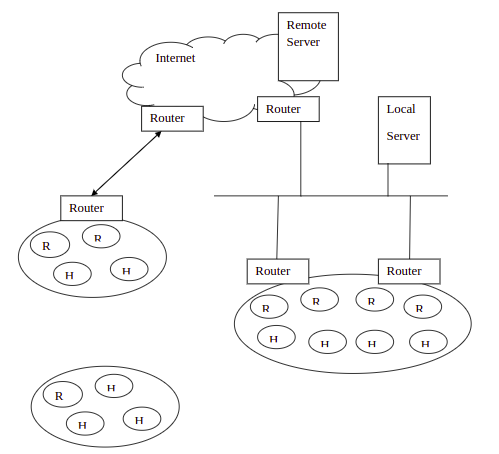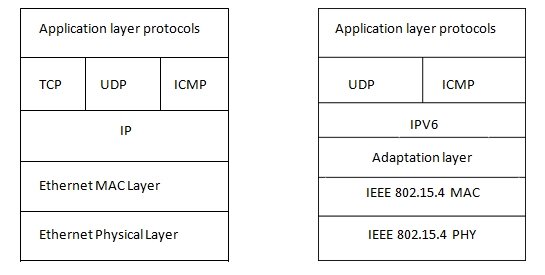– Vishalakshi R, Chaithra P, Srikanth N S
Published in IJECS, Volume 3 Issue, 7 July, 2014
ABSTRACT:
6LoWPAN (IPV6 over Wireless Personal Area Network) is a wireless personal area network that contain devices compatible with IEEE 802.15.4. Routing is the major issue in 6LoWPANs as the nodes are characterised by scarce memory, limited power, low battery life, limited resources and less cost. Routing protocols for such networks should be designed such that they make efficient use of available resource and should exhibit high performance. This paper presents a detailed survey of 6LoWPAN routing protocols, their comparison on several metrics such as memory power, power consumption, scalability, routing type, location information and many other factors.
- INTRODUCTION
Wireless Sensor Networks (WSN) is the area where majority of research work is taking place. WSN finds its application in military, Home automation, Industry automation, Hospital management, defence, Security, Smart grids etc. What comes in the near future is that all embedded devices characterised by low power, scarce memory capacity, small size, less cost to be connected through the Internet. That is, Internet of Things. Wireless Embedded Internet is a subset of Internet of Things.
The lack of an IP-based network architecture prohibited sensor networks from interoperating with the Internet. Considering this drawback, the IETF initiated the 6LoWPAN and RoLL working groups in order to define standards at different layers of the existing protocol stack to achieve the connectivity between low-power, lossy networks and the Internet. 6LoWPAN working group uses the standard IEEE 802.15.4 PHY layer and also describes how to transfer IpV6 packets over IEEE 802.15.4 networks. A LoWPAN is a collection of 6LoWPAN nodes that have first 64 bits of IpV6 address as common. LoWPANs are divided into Simple LoWPAN, Extended LoWPAN and Ad-hoc LoWPAN. The architecture of LoWPAN is shown in fig.1.1. Simple LoWPAN consists of several LoWPAN nodes connected to the Internet via backhaul link and an edge router. An extended LoWPAN is a collection of LoWPAN nodes in a larger scale which in turn are connected to the Internet through two or more edge routers and a backbone link. LoWPAN can also operate without infrastructure, called as Ad-hoc LoWPAN, where a LoWPAN node is configured as a simple edge router.
Here the IpV6 prefix used is local, not global. The Edge routers showed in the figure routes the traffic in and out of the network. They also handle neighbour discovery, 6LoWPAN compression and IpV4 interconnectivity. A LoWPAN node may act as a node or as a router including the edge router. LoWPAN nodes can participate in one or more LoWPANs (multi-homed) and they are free to roam around in LoWPAN and across LoWPANs. Communication between LoWPAN and IP Network is carried out in an end-to-end manner. Each node in a LoWPAN network is identified by unique IpV6 address, with the help of which they are able to send IpV6 packets. LoWPANs support ICMPv6 messages and they use User Datagram Protocol as transport layer protocol.

The rest of the paper is organized as protocol stack of 6LoWPAN, routing parameters and requirements, different routing protocols, comparison of routing protocols, conclusion and references.
2. Protocol stack of 6LoWPAN:
In a LoWPAN network some nodes restrict themselves to the role of hosts only but only few nodes may take part in routing also. The nodes that perform routing have more processing and storage capabilities. Fig. 2.1 shows IP protocol stack in comparison with the 6LoWPAN protocol stack.
Physical layer provides the basic communication capabilities. It is compliant with IEEE 802.15.4 and provides a data rate of 250kbps operating frequency of 2400-2483.5MHz and it supports a maximum payload of 127 bytes. Datalink layer enables reliable single-hop communication links between devices. LoWPAN is a non-beacon enabled network where data frames are sent via contention-based channel access method of Unslotted CSMA/CA. Adaptation layer is the most important layer of the 6LoWPAN. It performs TCP/IP header compression. IEEE 802.15.4 has a packet size of 128 bytes. But IpV6 header occupies 40 bytes header. UDP and ICMP both has 4 bytes header size and TCP occupies 20 bytes as header. So LoWPAN cannot transmit the data effectively without performing header compression. Adaptation layer handles fragmentation and reassembly. IpV6 has Maximum Transmission Unit of 1280 bytes while IEEE 802.15.4 has a packet size of 128 bytes. So this mismatch is handled in the adaptation layer. The major function of the adaptation layer is routing, where border WSNs should be able to route the packets to and from the LoWPAN and outside IP network. Adaptation layer also supports neighbour discovery and multicasting. Network layer provides Internetworking capability with the sensor nodes, provides security services, helps in network management using Simple Network Management Protocol (SNMP). Transport layer performs process-to-process delivery.

The term Routing usually refers to the formation of paths and forwarding of packets at the IP layer. But in LoWPANs routing can occur at the IP layer or below IP layer. There are four requirements defined for 6LoWPAN routing protocols, which are- low overhead on data packets, low routing overhead, minimal memory and computation requirements and support for sleeping nodes. The transmission of IpV6 packets over LoWPAN is difficult because of increased address space from 32 bits to 128 bits and minimum MTU of 1280 bytes whereas the required minimum MTU for IEEE 802.15.4 data link layer is 127 bytes. So, to support transmission of IpV6 packets over LoWPAN, an adaptation layer has been implemented between network and data link layer. Because of the adaptation layer, routing or forwarding decisions are taken either at the network layer or at the adaptation layer and also it eases IP packet transmission by header compression and fragmentation to support minimum MTU.
There exists number of IP routing protocols. But those existing routing protocols does not act according to the requirements of the 6LoWPAN nodes, because of the reasons like:
6LoWPAN routing protocols should support multiple device types and roles.
6LoWPAN routing protocols should exhibit better performance as 6LoWPAN nodes are having limited power, low battery life and small memory.
They should be able to handle sleeping nodes as 6LoWPAN nodes stay in sleep for most of the time.
Considering above reasons, routing protocols are designed specifically for 6LoWPANs.
